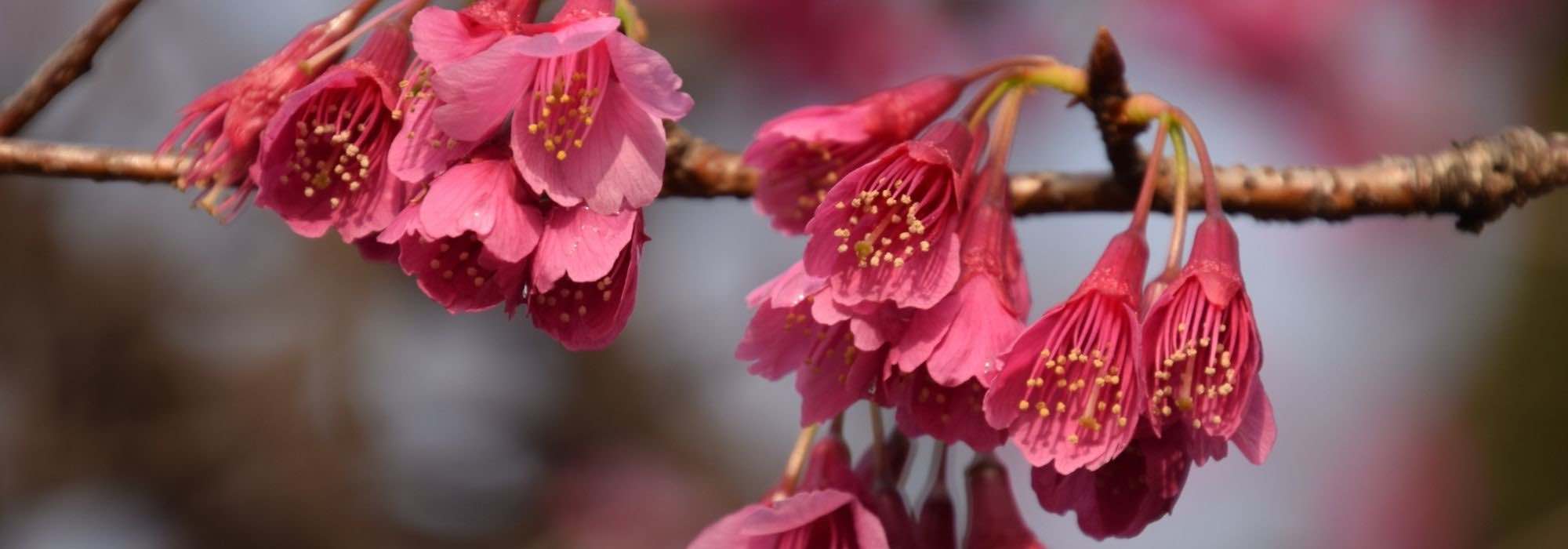
10 ideas for pairing Japanese Cherry Trees
Ideas for finally planting a Japanese Cherry tree at home!
Contents
Symbols of the arrival of Spring, Japanese Cherry Trees delight us with their delicate flowering in soft pink, sometimes dark pink or white. Their flowers, often single, can also be double in some varieties, but are always light and ready to be carried away by the breeze. Cherry Trees also have lovely deciduous foliage that usually blazes in autumn. Their bark is also attractive, frequently smooth and horizontally striate. There is a flowering Cherry Tree for every garden, terrace, and balcony: ranging from 2 to 8 m at maturity, they exhibit rounded or fastigiate habits and even weeping forms. They belong to the genus Prunus, which also includes peaches, almonds, and apricots. They are differentiated by their species: Prunus serrulata, Prunus incisa, Prunus x subhirtella, Prunus glandulosa.
To grow it, you will need a sunny or partially shaded location in the Mediterranean, with cool, well-draining soil that is fairly rich in organic matter and deep. Be sure to shelter it from cold winds. Discover how to incorporate it into the garden, in various settings and situations. If you have a balcony or terrace, do not hesitate to choose the more compact varieties.
With spring bulbs and perennials
Fresh and pastel-coloured, a Japanese Cherry on a carpet of bulbs is a delightful sight in spring. As the first flowers emerge after the winter’s nakedness, a joyful carpet of bulbs beneath the light and elegant flowering of a Cherry, eagerly awaited, creates an iconic spectacle of this season, full of vibrancy, under still gentle light. Admittedly, you won’t achieve a spreading flowering, but you will get maximum impact. Many bulbs bloom in early spring, leaving you spoilt for choice. Notable mentions include the essential Tulips, Daffodils, and Grape Hyacinths.
Here, a harmony of small bulbs is offered: the very pretty botanical tulips, such as tulipa clusiana ‘Cynthia’ and ‘Lady Jane’, paired with the fragrant Narcissus tazetta ‘Avalanche’ and Anemone blanda ‘Blue Shades’. The lovely Muscari neglectum joins this spring dance beneath a flowering Cherry ‘Pandora’.

Prunus ‘Pandora’, Tulips Clusiana ‘Cynthia’ and ‘Lady Jane’, Muscari neglectum, Narcissus tazetta ‘Avalanche’, Anemone blanda ‘Blue Shades’
In the background of a flower bed
The Japanese Cherry Tree showcases its lovely silhouette advantageously at the back of a border, punctuating it with its delicate flowering. Of modest or larger size depending on the varieties, it pairs well with all sizes of borders and all styles of gardens, whether romantic, Japanese-inspired, or even contemporary. Its lightness allows for many combinations.
You might envision a spring scene with a Flowering Currant, a Japanese Quince, or an Ornamental Apple Tree. You can also imagine an autumn scene with the fiery foliage of the Japanese Cherry Tree or the late flowering of Prunus subhirtella ‘Autumnalis Rosea’ alongside Asters and Japanese Anemones.
Here’s a vibrant spring example: Prunus cerasifera ‘Nigra’ is accompanied by Hydrangea aspera ‘Rosemary Foster’, an Viburnum opulus, a Hosta ‘August Moon’, and a grass: Panicum virgatum ‘Purple Breeze’.
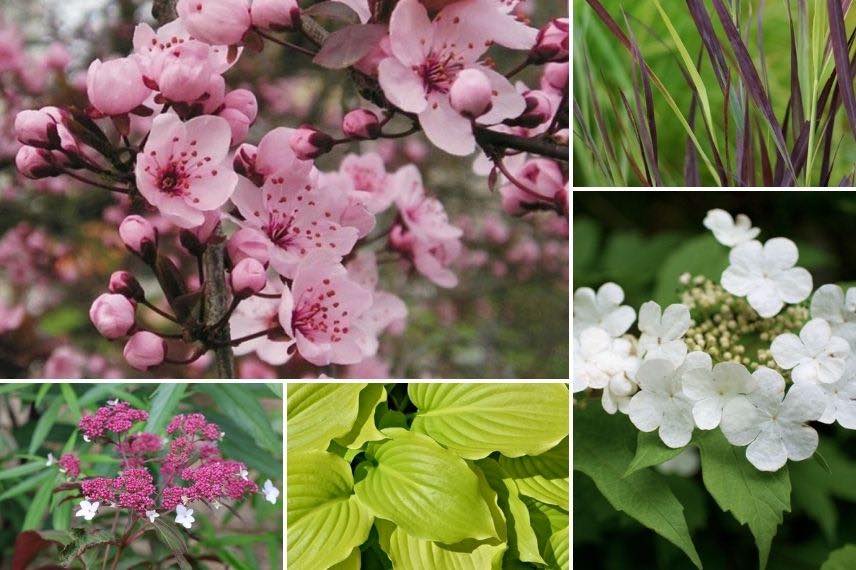
Prunus cerasifera ‘Nigra’, Panicum virgatum ‘Purple Breeze’, Viburnum opulus, Hosta ‘August Moon’, Hydrangea aspera ‘Rosemary Foster’
Discover other Prunus
View all →Available in 5 sizes
Available in 1 sizes
Available in 1 sizes
Available in 1 sizes
Available in 1 sizes
Available in 1 sizes
Available in 1 sizes
Available in 1 sizes
Available in 1 sizes
Available in 3 sizes
Japanese Cherry Trees
If you have the space and your heart beats for its flowering, planting several Cherry Trees creates a strong visual impact and you can enjoy their flowering from March to May. Although it is relatively short-lived, there is a choice between early and late varieties. Make a selection from the different habits and types of flowers, single or double.
For example, the Prunus Okame blooms abundantly in March-April with single pink flowers featuring a carmine heart, along with red-orange foliage in autumn and red bark in winter. The Prunus serrulata ‘Pink Perfection’ flowers in May with bright pink double flowers and brilliant red and orange foliage in autumn. As for the Prunus subhirtella ‘Pendula Rubra’, it has a weeping habit, light pink spring flowers, and yellow and red autumn foliage.
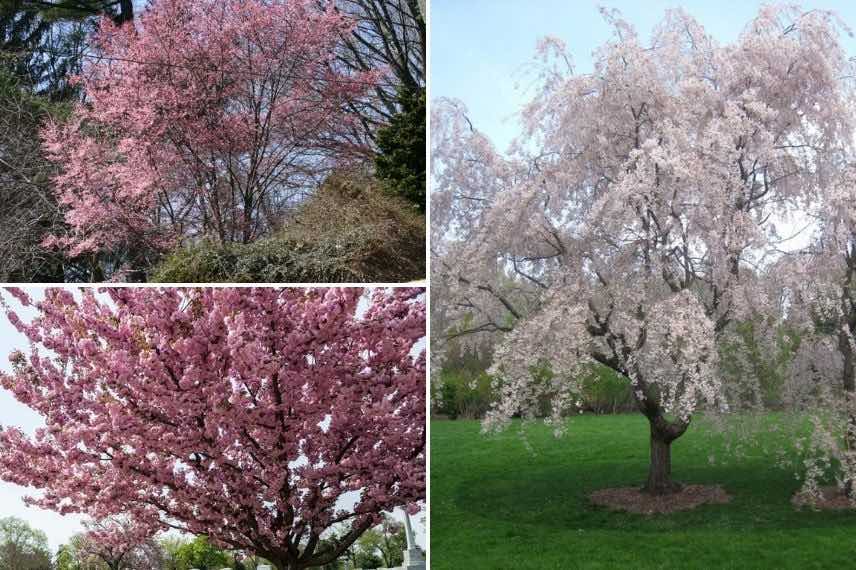
Prunus ‘Okame’, Prunus serrulata ‘Pink Perfection’, Prunus subhirtella ‘Pendula Rubra’
Isolated
Obviously, the Japanese Cherry is quite keen to draw attention solely to itself. In a garden, even a small one, compact varieties thrive when planted in isolation. In a larger space, taller and broader varieties flourish, creating an interesting focal point, both during flowering and in autumn with their colourful foliage, in winter with their bark, and all year round with their lovely branches. Choose a well-formed tree with a trunk and branch structure that you like.
The Japanese Cherry ‘Kanzan’ or Prunus ‘Kanzan’ is a very attractive specimen to plant in isolation, with multiple charms: its buds are a deep red and its numerous double flowers are raspberry pink. Its foliage emerges in copper tones and turns yellow-orange in autumn. It has a fairly tall and wide upright habit, reaching a height at ripeness of 7 m and a spread of 4 m. The Prunus myrobolan offers another example with a broad and graceful outline, simple flowers, and purple-black foliage.

A Prunus serrulata ‘Washi-no-o’ in all its majesty (photo Plant Image Library)
In a Japanese atmosphere
The atmospheres of Japanese gardens are created with foliage, textures, and shapes, occasionally enhanced throughout the year by some flowering: that of Camellias, Rhododendrons, Azaleas, or Japanese Cherry trees. If your garden has the right conditions for growing ericaceous plants, with a slightly calcareous, cool, humus-bearing soil in partial shade, then a Japanese-inspired scene is a beautiful setting for planting a Japanese Cherry tree. Choose to accompany it with some plants such as Ferns, Hakonechloa, Ophiopogons, a Japanese Maple, Bamboos, and Conifers.
Here is an example featuring a Acer palmatum ‘Katsura’, a Camellia transnokoensis, a Hakonechloa macra ‘Aureola’, a fern Dryopteris filix-mas, a conifer Picea glauca ‘Alberta Globe’, and a Prunus ‘Okame’.
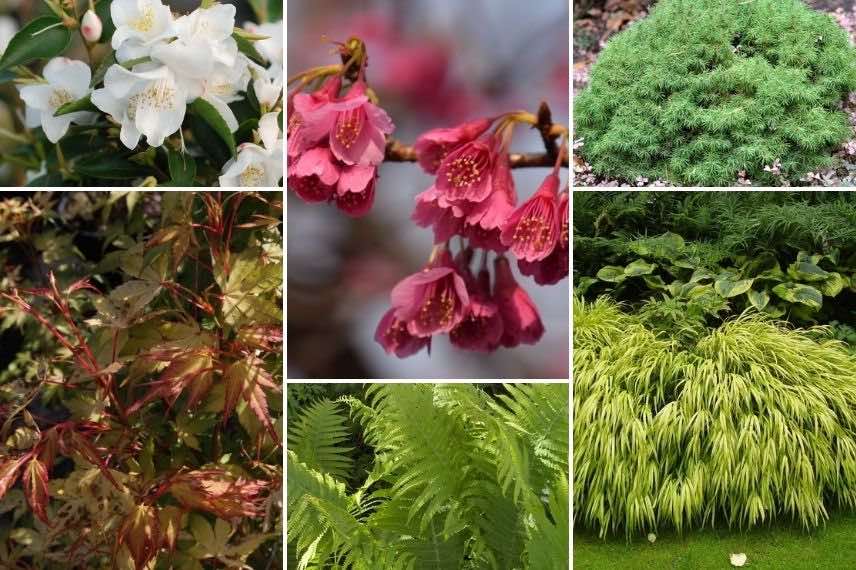
Camellia transnokoensis, Prunus ‘Okame’, Picea glauca ‘Alberta Globe’, Hakonechloa macra ‘Aureola’, Dryopteris filix-mas, Acer palmatum ‘Katsura’
In a pot, as a bonsai
Small varieties of Japanese Cherry with twisted branches make excellent subjects for bonsai or simply for pot planting. The famous Prunus incisa ‘Kojo No Mai’, shown here in the photo, offers its twisted habit to the patient tools of a bonsai enthusiast who will know to remove a few branches and prune here and there to reveal its branches. Don’t hesitate to try it for fun! Other varieties lend themselves to this exercise or to planting in a carefully chosen pot: the Prunus subhirtella ‘Autumnalis Rosea’ whose flowering begins in autumn and can last until spring; the Prunus incisa ‘Oshidori’ with its lovely double flowers.

Prunus incisa ‘Kojo no Mai’ (photo peganum)
In a hedge
A free and flowering hedge readily welcomes a Japanese Cherry tree among many decorative bushes. For example, plant a Honeysuckle, Lonicera xylosteum, a Flowering Almond, a Hawthorn, or a Flowering Peach. Choose varieties that are small or medium-sized, with a fastigiate habit.
Here, we are planting a Prunus glandulosa ‘Alba Plena’ alongside a Viburnum sargentii ‘Onondaga’, an Osmanthus ‘Heaven Scent’, and a Hornbeam, Carpinus betulus.
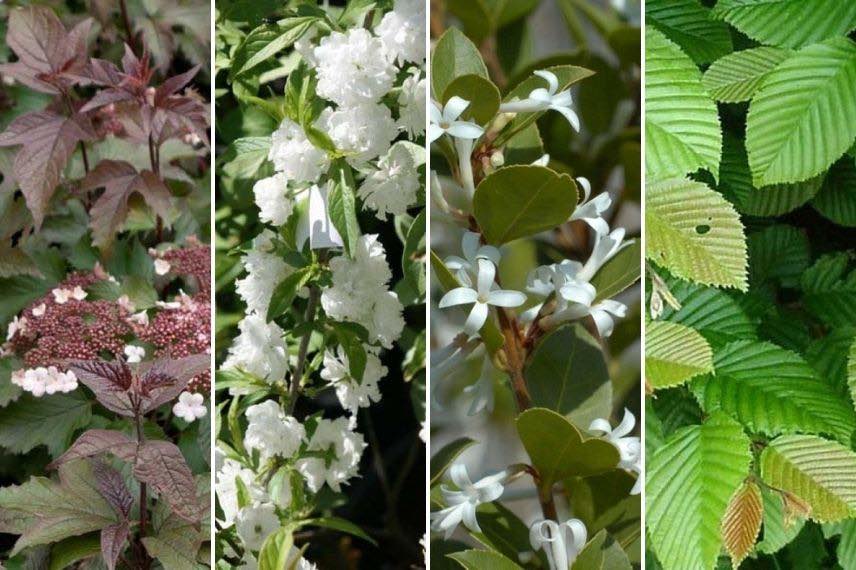
Viburnum sargentii ‘Onondaga’, Prunus glandulosa ‘Alba Plena’, Osmanthus ‘Heaven Scent’, and Carpinus betulus.
Creeping cherry, in rockery
Compact varieties like those mentioned earlier for pot planting can also be planted in a fresh, sunny rockery with low bushes or groundcover. Dwarf Japanese Cherry trees such as the varieties Prunus incisa ‘Paean’ and ‘Yamadei’, which are as wide as they are tall, at 2 m by 2 m, are also suitable for this type of setting.
Plant this kind of subject with creeping Ceanothus, a low Nandina, heathers, a Cotoneaster, an Exochorda, conifers…
Here, everything is in foliage and colourful flowering with Prunus glandulosa ‘Rosea Plena’, a Ceanothus ‘Blue Sapphire’, a Nandina ‘Obsessed Seika’, a Pieris ‘Bonfire’ and an Erica Carnea ‘Springwood White’.
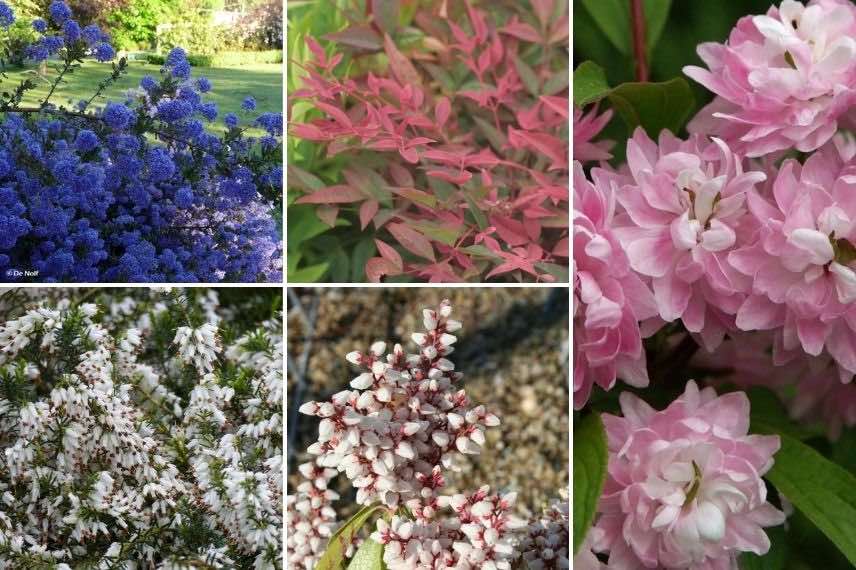
Ceanothus ‘Blue Sapphire’, Nandina ‘Obsessed Seika’, Prunus glandulosa ‘Rosea Plena’, Pieris ‘Bonfire’, Erica Carnea ‘Springwood White’
Coupled with a climbing
Train a plant to climb your Japanese Cherry tree that will reach the top of the tree. It brings flowers when it has lost its own, and is even present in winter when the foliage of the Cherry has disappeared. Choose a summer-flowering climbing plant or an evergreen climbing plant with winter flowering. For example, Clematis ‘Little Mermaid’ will look lovely on a compact Cherry tree. It flowers in May and again at the end of summer. For winter flowering, Clematis cirrhosa ‘Advent Bells’ is a beautiful choice.
On your table
If you have a tropic movement for Japanese culture, you can also choose to enjoy your Cherry tree flowers and leaves as well. Browse through Japanese culinary literature and you will find various ways to prepare them. The leaves are most often preserved in salt, while the flowers can be sprinkled fresh over a dish. Known as Sakura flowers, they can also be fermented and preserved in salt like the leaves or ground into powder.
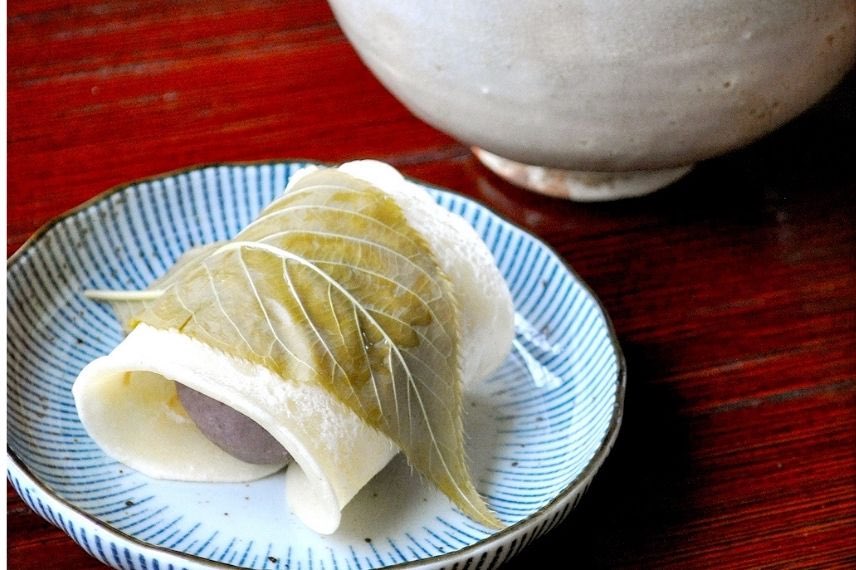
Salted cherry leaf on mochi (photo Thierry Del Socorro)
- Subscribe!
- Contents


































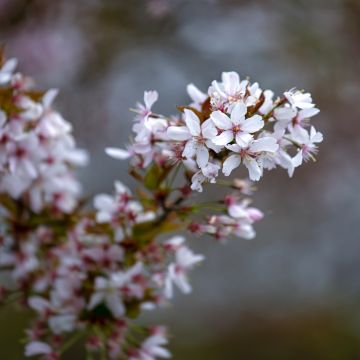
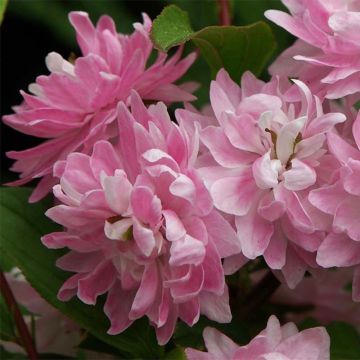
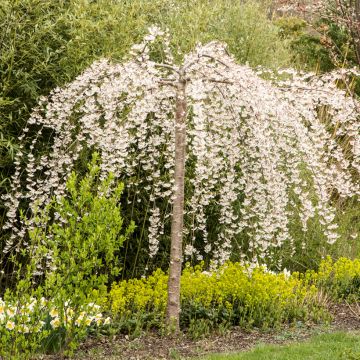
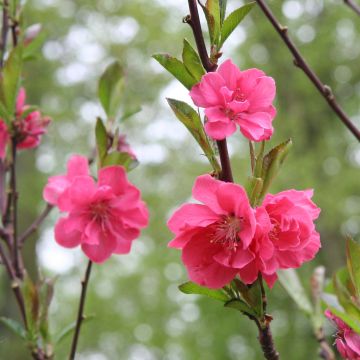

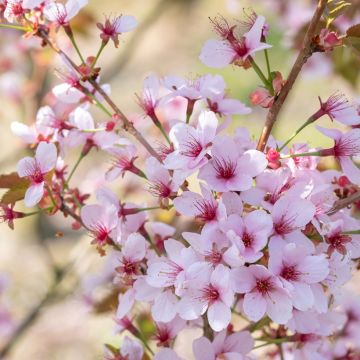
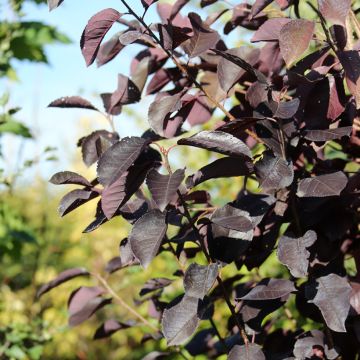
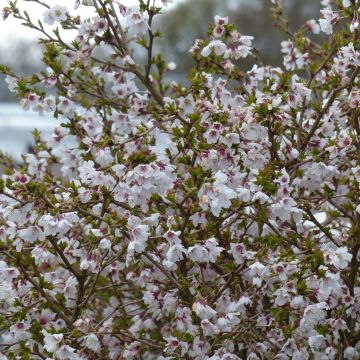
Comments